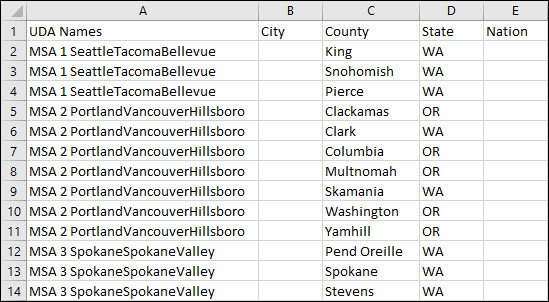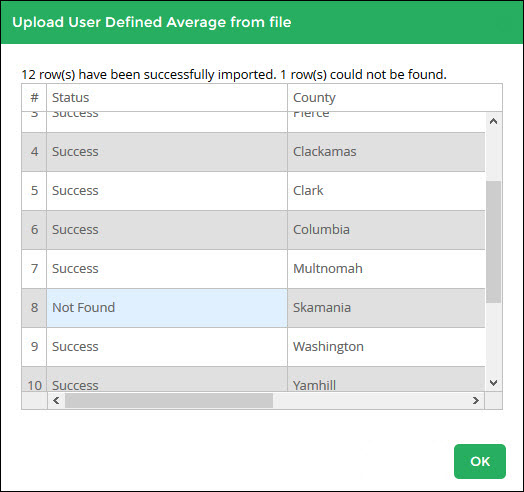The Executive Compensation Assessor (XA) allows users to import multiple UDAs from a single file.
To import one or more UDAs, first save your area list. Create a list of postal codes, cities, counties, or states associated with one or more UDAs using a program like Microsoft Excel and save it as a .CSV (comma delimited) file. ERI provides users with a .CSV file template to simplify the upload process. See instructions below.
To Create a .CSV File
1.From any of the main tables: In Organization Data, click the Averages button in the Area field to open the User-Defined Averages tab in the Browse Areas dialog.
From Advanced Reports: To add a new area, click the  button to open the Browse Areas dialog. Click the User-Defined Averages tab. button to open the Browse Areas dialog. Click the User-Defined Averages tab. |
2.Click the  button to download and save a .CSV file template.
button to download and save a .CSV file template.
3.Open the .CSV file template using a spreadsheet program like Microsoft Excel.
4.Fill out the template. Required columns are designated with an asterisk (*).
States can be listed in full or using abbreviations (e.g., Washington or WA) in the state column. Canadian provinces must be listed under state. The citystate column is designed to include both the city and state in this format: Seattle, Washington. To import a list of counties, the .CSV file must have three separate columns for county, state, and UDA (the name of the user-defined average associated with the county). See Assessor Series FAQ #40 for suggestions on how to format ZIP codes correctly in Excel for export to an Assessor Series application. Averaging areas in more than one country is not allowed.
The following is example displays the correct format for a .CSV file containing multiple UDAs:

Any data that is not formatted correctly in the .CSV file will not be displayed in the user-defined average.
5.Once the table is complete, give the file a unique name and save the file in the .CSV (comma delimited) format.
6.Close the .CSV file.
Note: If you are importing a list of multiple UDAs and have pre-existing UDAs stored in the Executive Compensation Assessor, consider using a prefix in the UDA names in the .CSV file so that these new UDAs are listed together in the Search Area screen. In the example above, some of the UDA names include numeric prefixes (MSA 1, MSA 2, and MSA 3) so that they are sorted together in numeric order within the alphabetized UDA filter.
To Import a .CSV File
1.From any of the main tables: In Organization Data, click the Averages button in the Area field to open the User-Defined Averages tab in the Browse Areas dialog.
From Advanced Reports: To add a new area, click the  button to open the Browse Areas dialog. To change an area already displayed in the table, select the area and click the Browse button to open the Browse Areas dialog. Click the User-Defined Averages tab. button to open the Browse Areas dialog. To change an area already displayed in the table, select the area and click the Browse button to open the Browse Areas dialog. Click the User-Defined Averages tab. |
2.Click the  button.
button.
3.In the Upload User-Defined Averages dialog, click the Browse button to select the .CSV file to upload and then click Open. Then click OK.
4.A message will display the number of rows that you have successfully imported. If the .CSV file contains any errors, then a message will display the number of errors encountered during the import and will list the areas needing review (see example below).
6.To export the results to Excel, click  .
.
7.In the Choose Export Preferences dialog, select one of more of these options to export:
•Errors
•Warnings
•Successes
8.Click OK in the Choose Export Preferences dialog.
9.Click OK in the Upload User-Defined Averages from file dialog to return the User-Defined Averages tab.
10.All user-defined averages saved in the .CSV file will be uploaded at once, but they will be listed separately in the User-Defined Averages dialog.
The following screenshot displays the upload status for the example of a .CSV file containing multiple UDAs shown above. Notice that the status of Skamania County is "Not Found" because the Executive Compensation Assessor database does not contain active cities with survey data in this rural county.

The following screenshot displays the new UDAs from the example above in the Search Area dialog under the User-Defined Averages filter. Notice how the numeric prefixes in the UDA names allow us to sort the new UDAs easily.

See My Organizations to share lists (or make them private) and manage permission status.
To Create a User-Defined Average
See Create User-Defined Average
To Edit a User-Defined Average
To Select a Previously Defined User-Defined Average